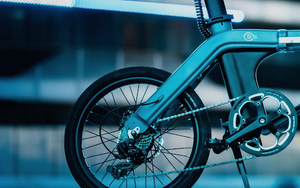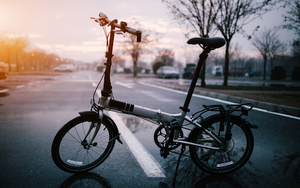Are Electric Bikes Waterproof?
Aug 13, 2024
Electric bikes, also known as e-bikes, have gained immense popularity in recent years due to their eco-friendly nature and convenience. However, potential buyers often question the water resistance of these bikes. Can electric bikes withstand rainy weather or puddles without damage? In this article, we will discuss the waterproof nature of electric bikes, the factors affecting their water resistance, and how to protect them from water damage.
The Electric Bike Market
Electric bike adoption is growing fast, with the global e-bike market worth over $20 billion and predicted to grow at a CAGR of 14.5% by 2030. With global pressures to reduce carbon emissions, and individual countries having their own targets to meet, electric bikes are predicted to soar.
Understanding Electric Bike Construction
Before delving into the waterproof capabilities of electric bikes, it's crucial to understand their construction. Electric bikes consist of several key components that work together to provide the desired functionality. These components typically include the motor, battery, controller, wiring, and display unit.
- The motor is the powerhouse that drives the bike forward, while the battery supplies the necessary electricity.
- The controller manages the flow of power between the battery and motor.
- The wiring connects all the electrical components, ensuring seamless communication.
- Lastly, the display unit provides information about speed, distance, and battery level.
Key Components of an Electric Bike
Each component plays a crucial role in the overall function of an electric bike. While the motor and battery are usually sealed, other components may have varying degrees of protection against water.
Material and Design: How it Affects Water Resistance
When it comes to water resistance, the material and design of an electric bike play a significant role. Manufacturers use different materials, such as aluminium and carbon fibre, to construct electric bike frames. These materials offer varying levels of water resistance.
Additionally, the design of the bike also impacts its ability to withstand water. Bikes with enclosed or hidden wiring tend to be more water-resistant compared to those with exposed wiring. Similarly, bikes with proper sealing around the battery compartment and connectors provide better protection against water ingress.

The Concept of Waterproofing in Electric Bikes
Now that we understand the components and their role in water resistance, let's delve into the concept of waterproofing itself in the context of electric bikes.
Defining 'Waterproof' in the Context of E-Bikes
The term 'waterproof' suggests that a device is impervious to water, even when submerged to a certain depth or exposed to rain or water splashes. However, achieving complete water resistance in electric bikes can be challenging due to various factors such as design constraints and cost considerations.
Manufacturers often aim for a certain level of protection against water ingress. This protection is usually described using an IP (Ingress Protection) rating.
The IP Rating System and Electric Bikes
The IP rating system is a standardised measure that indicates the level of protection against solids and liquids. The IP rating consists of two digits, with the first digit representing solid particle protection, and the second digit indicating liquid ingress protection.
For electric bikes, the higher the second digit of the IP rating, the better the water resistance. It is common to find electric bikes with an IP rating of IPX4 or higher, indicating that they are resistant to splashes of water from any direction. For example, the Engwe M20 Electric Cruiser Bike has an IPX5 waterproof rating.
Factors Affecting the Waterproof Nature of E-Bikes
While electric bikes strive to offer water resistance, several factors can affect their ability to withstand water exposure. Let's explore some of the key factors that influence the waterproof nature of e-bikes.
Impact of Weather Conditions on E-Bikes
Weather conditions, particularly intense rain or exposure to water for prolonged durations, can pose challenges to the waterproof capabilities of electric bikes. While most e-bikes can handle light rain without significant issues, heavy rainfall or riding through deep puddles might increase the risk of water damage.
Manufacturers often recommend avoiding submerging electric bikes in water or riding through flooded areas to protect the electrical components and ensure long-term durability.
The Role of Maintenance in Preserving Waterproof Features
Maintenance plays a vital role in preserving the waterproof features of electric bikes. Regular maintenance checks and preventive measures can help ensure the longevity of the bike's water resistance.
Periodically inspecting the seals, connectors, and wiring for any signs of wear or damage is essential. Additionally, keeping the bike clean and dry, especially after riding in wet conditions, can help prevent moisture buildup and potential water damage.

How to Protect Your Electric Bike from Water Damage
Although electric bikes come with varying degrees of water resistance, taking proactive measures to protect them from water damage is always advisable. Here are some practical tips to safeguard your electric bike in wet conditions.
Precautions to Take During Rainy Seasons
During the rainy seasons, taking extra precautions can help protect your electric bike from water damage. Consider using fenders to prevent water splashes from hitting sensitive components. Installing a bike cover or finding sheltered parking can provide additional protection from heavy rain.
Furthermore, if you plan to ride in heavy rain, consider using waterproof accessories like handlebar bags or panniers to keep your belongings dry and avoid water seeping into battery compartments or connectors.
Essential Waterproof Accessories for E-Bikes
Using waterproof accessories can offer added protection to your electric bike. Consider investing in a waterproof bag or case for your display unit and controller. These accessories can prevent water from seeping into vital components and potentially causing damage.
Additionally, using a waterproof saddle cover and protecting the battery and motor connectors with silicone covers can help maintain the water resistance of these sensitive areas.
The Limitations of Waterproof Electric Bikes
While electric bikes strive to be water-resistant, it's important to understand their limitations in handling water exposure. Here are some factors to keep in mind.
Understanding the Risks of Water Exposure
Even with the highest IP rating, complete water protection is not guaranteed. High-pressure water jets, submergence in water, or prolonged exposure to heavy rain can still pose risks.
Water damage can lead to malfunctioning of electrical components and compromise the overall performance of the bike. Therefore, it's crucial to exercise caution and avoid excessive water exposure.
When Waterproof Doesn't Mean Water-Proof
It's important to note that waterproof does not mean water-proof. While electric bikes are designed to resist water to a certain extent, they might not withstand extreme water conditions or complete submersion.
Therefore, it is recommended to refer to the manufacturer's guidelines and follow their recommendations regarding the water resistance capabilities of your specific electric bike model.

So, Are Electric Bikes Waterproof?
In conclusion, electric bikes offer various levels of water resistance, and the extent of their ability to withstand water exposure depends on multiple factors such as design, materials, and maintenance. While they are built to handle light rain and water splashes, it is crucial to take precautions during heavy rain and avoid immersing them in water. By following manufacturer guidelines and practising regular maintenance, you can enjoy the benefits of an electric bike while ensuring its durability even in damp conditions.
You can view our full range of electric bikes here, whereby all specifications and details on their waterproofing status can be seen within the product descriptions.






